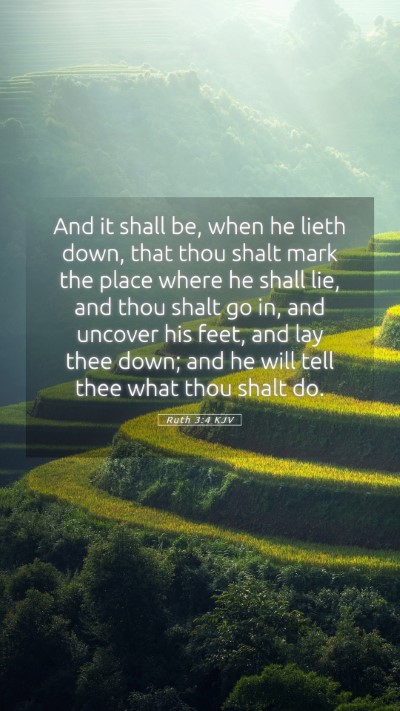Old Testament
Genesis Exodus Leviticus Numbers Deuteronomy Joshua Judges Ruth 1 Samuel 2 Samuel 1 Kings 2 Kings 1 Chronicles 2 Chronicles Ezra Nehemiah Esther Job Psalms Proverbs Ecclesiastes Song of Solomon Isaiah Jeremiah Lamentations Ezekiel Daniel Hosea Joel Amos Obadiah Jonah Micah Nahum Habakkuk Zephaniah Haggai Zechariah MalachiRuth 3:4 Meaning
What is the meaning of Ruth 3:4?
And it shall be, when he lieth down, that thou shalt mark the place where he shall lie, and thou shalt go in, and uncover his feet, and lay thee down; and he will tell thee what thou shalt do.
Ruth 3:4 Bible Verse Meaning
Understanding Ruth 3:4
Verse: "And it shall be, when he lieth down, that thou shalt mark the place where he shall lie, and thou shalt go in, and uncover his feet, and lay thee down; and he will tell thee what thou shalt do." (Ruth 3:4)
Overview of Ruth 3:4
This verse presents a pivotal moment in the narrative of Ruth, emphasizing the themes of trust, submission, and the cultural practices of ancient Israel regarding marriage and redemption. It serves as an instruction from Naomi to Ruth on how to approach Boaz, demonstrating her boldness in seeking security and recognition as a relative.
Bible Verse Commentary
This commentary explores the significance of the instructions given by Naomi to Ruth, which entail a series of culturally significant actions:
- Marking the Place: Naomi's directive to observe where Boaz lies is reflective of Ruth's careful planning and the importance of timing in her approach.
- Uncovering His Feet: This act can be interpreted in various ways, but it generally denotes a humble request for protection and marriage, symbolizing Ruth’s commitment.
- Submission to His Authority: Laying down at Boaz's feet signifies a posture of submission, acknowledging his role in the family and cultural dynamics of redemption.
Insights from Commentaries
Matthew Henry: Henry explains that this moment illustrates Ruth's faith and obedience, as she acts under Naomi's guidance. The uncovering of Boaz's feet symbolizes a request for his protection, as well as invoking his role as a kinsman-redeemer.
Albert Barnes: Barnes emphasizes the importance of the social customs of the time, highlighting how Ruth's actions were laden with intentions of seeking a new covenant of marriage and positioning herself within Boaz's family, which reflects the unfolding plan of God.
Adam Clarke: Clarke discusses the context of the agriculture community and the role of the guardian-redeemer, noting that Ruth's bold move, while culturally risky, was driven by her loyalty and desire for family security, mirroring the larger redemptive story of Israel.
Application of Ruth 3:4
The significance of this verse extends beyond its immediate historical context. For modern believers, it serves as a reminder of:
- Trusting Divine Guidance: Just as Ruth followed Naomi's instructions, so are we called to trust the guidance of God and those He places in our lives.
- Acting with Intention: Ruth's actions were purposeful. In our Bible study insights and discussions, we are encouraged to act with intention in our spiritual journeys and relationships.
- Understanding Redemption: This verse foreshadows the greater redemption found in Christ, illustrating how God orchestrates relationships for His divine purposes.
Related Bible Cross References
- Leviticus 25:25: The law of redemption concerning relatives.
- Deuteronomy 25:5-10: The duty of a brother-in-law to marry the widow.
- Matthew 1:5: Ruth is mentioned in the genealogy of Jesus, highlighting her importance in God's plan.
Conclusion
Ruth 3:4 serves as a powerful reminder of the principles of loyalty, cultural significance, and divine providence. Understanding the actions and motivations in this verse allows believers to gain deeper Bible verse meanings and interpretations as they explore the richness of Scripture.


